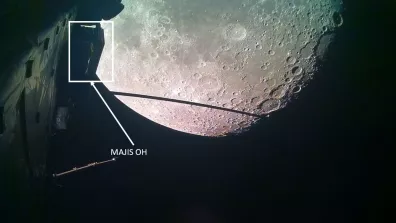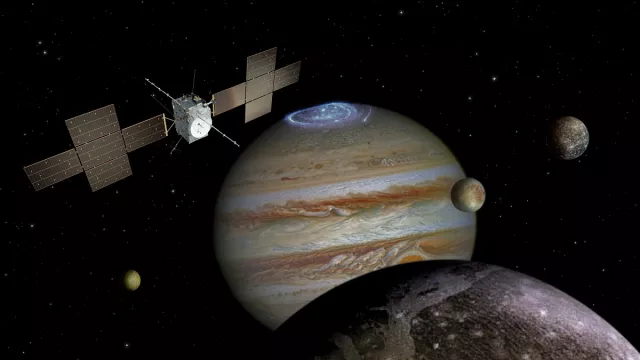The JUICE mission (JUpiter ICy moons Explorer) launched on 14 April 2023 by Ariane 5 from the Guiana Space Centre is setting out to study Jupiter and three of its moons with a view to gaining new insights into how life emerged.
Key information
Key figures
- 15 contributing French laboratories
- 12 instruments on spacecraft
- 9 months in Ganymede orbit
- 4 gravity assists
Key milestones
- September 2035: Scheduled end of mission
- December 2034: Insertion into Ganymede orbit
- July 2031: Arrival at Jupiter, starts exploring the planet’s moons
- January 2029: Swings by Earth for gravity assist
- September 2026: Swings by Earth for gravity assist
- August 2025: Swings by Venus for gravity assist
- August 2024: Swings by Earth-Moon system for gravity assist
- 14 April 2023: Launched by Ariane 5 from Guiana Space Centre
Project in brief
What are the conditions necessary for planets to form and life to emerge? How was our solar system born? These are fundamental questions the JUICE mission will be attempting to answer starting in 2031 by exploring Jupiter and three of its moons.
Over the course of three and a half years, JUICE will focus particularly on Ganymede, a moon thought to harbour a liquid ocean beneath its icy crust. By analysing this liquid ocean, JUICE will gather precious data about the conditions required for the appearance of life in this type of environment.
The mission will also be studying two other Jovian moons, Europa and Callisto.
Lastly, JUICE will probe Jupiter’s atmosphere and magnetosphere—the layer of a planet’s atmosphere where physical characteristics are governed by its magnetic field—and how it interacts with its moons.
The JUICE mission is part of ESA’s Cosmic Vision 2015-2025 programme. France is supporting several French research laboratories—(GEOPS, IAS, IMCCE, IPAG, IPGP, IRAP, LAB, LAM, LATMOS, LERMA, LESIA, LMD, LPC2E, LPG, LPP, OCA)—that worked on developing the satellite’s instruments.
These include the French MAJIS instrument (Moons And Jupiter Imaging Spectrometer), designed to characterize the surface of Jupiter’s icy moons, supplied by the IAS space astrophysics institute in Orsay, France under a technical partnership with CNES. The agency funded industrial contracts for all of the French contributions, for MAJIS and the laboratories that worked on the five other instruments.
CNES’s role
CNES is helping to fund JUICE through ESA's mandatory scientific programme and directly through the national programme via France's contribution to the satellite’s instruments. CNES, representing France on ESA's Science Programme Committee, is responsible for the French deliverables.
CNES is overseeing the contribution from all French participants (CNRS, universities). As such, it:
- is funding the contributions of the French laboratories
- oversaw development of the French contributions
- supplied support where needed by laboratories for quality insurance, mechanical engineering, thermal systems and component expertise, etc.
- is managing the interface with ESA for technical and programmatic aspects
is funding French mission science activities
Contacts
Project Leader
Charlène Doucet
E-mail: charlene.doucet at cnes.fr
Solar System Planets and Small Bodies subject matter expert
Francis Rocard
E-mail: francis.rocard at cnes.fr
Sun, Heliosphere & Magnetospheres (SHM) subject matter expert
Kader Amsif
E-mail: kader.amsif at cnes.fr
Project news



